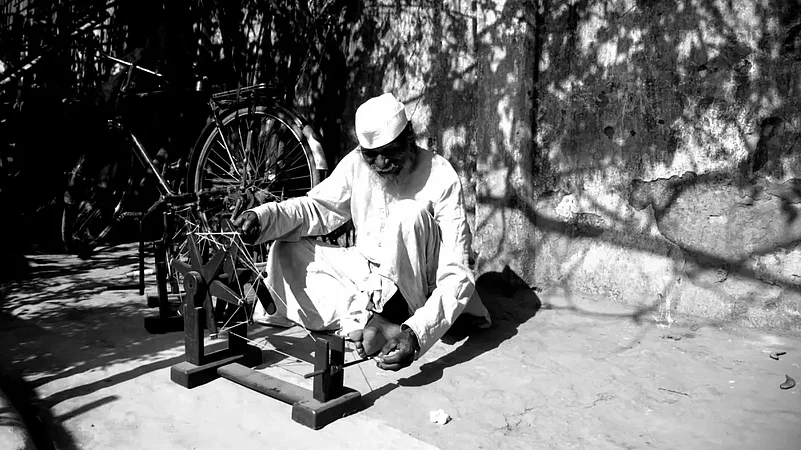In October 1925, in his ‘Bihar Notes’ published in Young India, Gandhi described the Tana Bhagats as dedicated bhaktas who had upheld his principles. They were believers in khaddar, plied the charkha regularly, wore khaddar that they had woven, and sang bhajans in chorus. Many of them had walked miles with charkhas on their shoulders. He saw nearly 400 of them all plying their charkhas most assiduously at the meeting he had addressed.
Who, then, are these Tana Bhagats? Over a hundred years ago in April 1914, as colonial records indicate, Jatra Oraon of Gumla, Ranchi, proclaimed that he had received a divine message from Dharmes, the God of the Oraons. Jatra was to be a king and his followers, the Tana Bhagats, were to share his kingdom. Reciting what he claimed to be divinely-inspired mantras, Jatra advocated that Oraon religion should be freed of evils like ghost-finding and exorcism, belief in bhuts and animal sacrifice, and the consumption of alcohol. As new leaders emerged, the Tana Bhagat movement spread across Ranchi, Palamau and Hazaribagh districts and to the princely states of Udaipur, Jashpur, Koriya and Sirguja.
From the 1920s onwards, new instructions were issued to the Tanas: the followers were to carry the Congress jhanda, wear khaddar, and take vows in the name of Gandhi Maharaj. The Tana Bhagats became members of the Congress by paying four annas. They attended annual sessions of the Congress party, participated in processions and hartals, organised panchayats, supported the non-cooperation thanas, spun the charkha, and participated in the no-rent campaign advocated by Congress during Gandhi’s Non-Cooperation and Civil Disobedience movements. Stories, myths, and rumours developed around the miraculous powers of Gandhi Baba, his charkha, and swaraj.
It is important to remember that earlier on, in tours across Bihar, Gandhi had explained his ideas of non-cooperation. The people should sever their connection with the government; they should use swadeshi articles; children should leave their schools; the women and girls of India should take to the charkha or spinning wheel; and so on. In 1920, the Bihar Provincial Conference supported Gandhi’s call for non-cooperation. By the close of 1920, Congress leaders had arrived in Ranchi. Processions, hartals, and meetings were held, and an organisational network of Congress was set up. Local volunteers were asked to launch temperance and anti-liquor campaigns, set up schools for primary education, establish panchayats and sabhas for deliberating on local conflicts, collect muthia for the national fund, and propagate the idea of swadeshi.
For the Tana Bhagats, rent and chaukidari tax lay beyond the realm of the traditionally accepted modes of payment in Chhotanagpur and were therefore denounced; the court as an alien institution of control was opposed; the anti-liquor campaign was aligned with the Tana practice of the renunciation of alcohol; Gandhi’s policy of ahimsa was in consonance with their ideas of vegetarianism. The Tana Bhagats now participated in large numbers in Congress politics and travelled long distances to attend Congress meetings. For example, as reported in The Searchlight, at the Gaya Congress in 1922, they were present in large numbers.
Colonial officials reported Tana Bhagats’ contribution to other Congress activities. They had contributed to the Tilak Memorial Swaraj Fund, participated in the National Week of 1923 and the khaddar exhibition of 1926, canvassed for subscriptions to the Lajpat Rai Memorial Fund, and waved black flags in demonstrations against the Simon Commission.
How, then, did the Tanas view Gandhi? Gandhi was more than a mere leader in flesh and blood; he featured in their dreams as Gandhi baba, a messiah who would lead them to a perfect and ordered world, to the utopian world of the Gandhi raj. As stories grew around him and tales of his miraculous powers spread, he emerged as an alternative source of authority. The ‘Angrez Raj’ would be ousted and the ‘Gandhi Raj’ would come in a year or two. The idea of swaraj, with which Gandhi’s name was associated, was polysemic. It represented a regime where hierarchies would be reversed and norms revised. It indicated times when food would be in plenty and prices would be controlled. It signified a rule where Tanas were the lords and decisions would be taken in panchayats. It symbolised the raj of the Oraons where they would be the masters of their land and there would be rent-free land.
The Tana Bhagats continue even today to battle for their rights, claiming to be, as followers of Gandhi, worshippers of truth and non-violence. Wearing clothes made of khaddar and with Gandhi topis on their heads, they walk in processions down the streets of Ranchi blowing conch shells. They sit on dharnas and hartals and submit petitions before government officials, demanding for themselves land that they claim they had lost for their participation in the Non-Cooperation, Civil Disobedience, and Quit India movements.
It is their link with Gandhi that empowers the Tana community and enables Tana Bhagats to negotiate with the state as they talk about promises that were never fulfilled by the sarkar. On October 2, on Gandhi Jayanti, they remember Gandhi as ‘Gandhi Baba’, a deity included within the pantheon of their deotas who will address their distress due to his allegedly extraordinary powers to deliver divine justice. Caught between an almost lost past, a difficult present and an uncertain future, and finding many of their practices economically unviable to sustain, the Tana Bhagats continue with their long battle, a battle that is being patiently fought, but still remains to be won.
(Dr Sangeeta Dasgupta teaches at the Centre for Historical Studies, Jawaharlal Nehru University, New Delhi. This article draws from her book titled Reordering Adivasi Worlds: Representation, Resistance, Memory.)





















